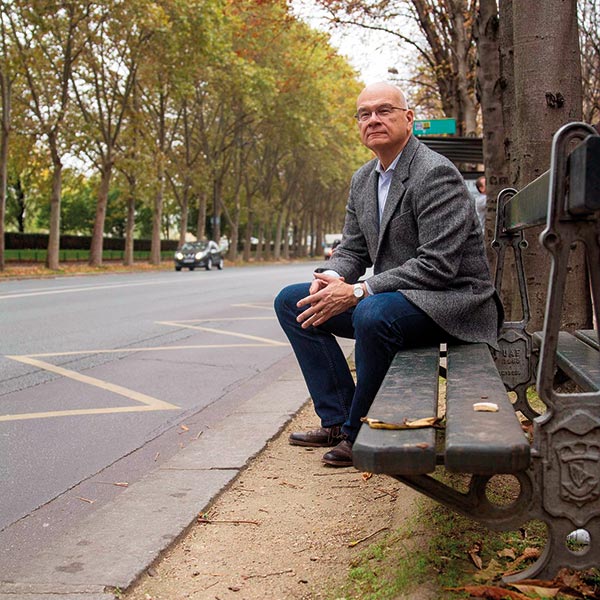Subtotal: $
Checkout-

What Is Time For?
-

Poem: “South Head, a Wild Surmise”
-

Poem: “Lammergeier”
-

Poem: “World Within”
-

When Love Seems Impossible
-

Places to Think with Neighbors
-

Letters from Readers
-

Covering the Cover: The Enemy
-

Thanksgiving Starts in September
-

The Monsignor versus the Fascists
-

Do Activists Need Enemies?
-

The Making of Martyrs
-

Visions of the Kingdom
-

Foolhardy Wisdom
-

Tough Love on the Mount
-

Walls behind Bars
-

My Mind, My Enemy
-

Demining the Sahara
-

Just Doing What Christians Do
-

Hating Sinners
-

Students Brave the Heat
-

The Witching Hour
-

Enemy Lovers
-

How God Sees Us
-

Macedonia Morning

Tim Keller: New York’s Pastor
The quintessential Manhattan pastor held the door open to everyone.
By Susannah Black Roberts
May 15, 2024
In the days after 9/11, New Yorkers read in the Times that Jerry Falwell had told them they deserved it. They were God’s enemies, and, presumably, Falwell’s too.
The Sunday before 9/11, Redeemer Presbyterian Church’s weekly attendance hovered at 2,800, after two decades of slow but steady growth. On September 16, 5,400 people attended a service. Around 800 new members were added to the rolls in the weeks afterward.
The sermon Tim Keller had planned for that Sunday had been on Jonah – the prophet who, sent to a great and sinful city, attempts to avoid going at all costs, because he is so irritated at the prospect that God loves it and its people and is eager to forgive them. Keller scrapped that one. He preached that Sunday instead on the raising of Lazarus.
When Jesus reaches the house of his friends Mary and Martha and finds that their brother Lazarus is dead, he weeps. “When somebody says to me, ‘I don’t know that God cares about our suffering, I don’t know that God cares about it at all,’ I say, ‘Yes, he does,’” said Keller from the pulpit that morning to the sea of new faces, people who did not ordinarily go to church at all.
They say, “How do you know?” Well, I’ll tell you something. If I was in any other religion I wouldn’t know what to say. But what I can say is: the proof is he was willing to suffer himself. I don’t know why he hasn’t ended suffering and evil by now, but the fact that he was willing to be involved and he himself got involved … [shows that] he is not remote.
Jesus was not absent from New York that Sunday.
Ten years after 9/11, polling revealed that attendance at evangelical churches in the city had tripled. According to Colin Hansen’s biography of Keller, between 1989 and 2019 the number of Manhattan residents attending such churches grew from nine thousand to over eighty thousand.
Keller’s wife, Kathy, gives credit for this where it is, primarily, due. “You want to know how to plant a successful church? Find out where God is beginning a revival, and move there the month before.”
Keller did not have a burning ambition to be accepted by the people of New York when he and Kathy moved there from rural Virginia in 1989. This was helpful in shaping him into someone able to challenge New Yorkers as well as contextualize the gospel for them.
“It’s surprising that so many educated twenty- and thirty-somethings would attend a church that teaches against sex outside marriage,” Kathy Keller once said to a journalist, who laughed: “Yes, that would be surprising.”
“No,” said Kathy, “I’m saying that’s what we actually teach.”
Keller ministered to secular New Yorkers, but he ministered as well to many who were raised evangelical outside the city and moved there after college: those who, one might think, are primed to shed their Christianity, finding that it can’t coexist with their love of the city’s culture or their city-sized ambition (in New York these things are often fused.)

Photograph by Arianne Ramaker. Courtesy of TimothyKeller.com.
When these people started going to Redeemer, they watched Babette’s Feast, because Keller couldn’t really go for very long without recommending it. The story is of a great Parisian chef who, after spending years serving a pair of sisters in a remote, pious village in Jutland, wins the lottery and spends her winnings on a feast that overcomes the villagers’ dour asceticism.
Evangelicals who saw the film experienced themselves as the ones who had lived lives of duty, and who were now given permission to pursue beauty. They found in this the gospel of grace: Jesus pouring out his riches, inviting them to taste and see that the Lord is good, and also letting them know that they could get involved in all kinds of pursuits of excellence and beauty. They were encouraged, at Redeemer, to be actors, singers, musicians, artists, or filmmakers. Redeemer’s urban take on the creation mandate told them that much of what they’d been raised to think was questionable because it was not evangelism might be worthwhile in itself.
When those raised in New York, or imbued in its culture, come to Redeemer, they do not need to be told that art and beauty and excellence are worthwhile in themselves; they have been raised on that gospel. And if they are succeeding in New York, they are succeeding on its terms. But if they are succeeding in New York, and if they have any imagination at all, they know that isn’t enough.
They also watch Babette’s Feast. There’s a scene at the end, after the feast is over, when all that remains are dirty dishes. In Isak Dinesen’s original book version, the line of dialogue between Babette and one of the sisters says, “‘I feel, Babette, that this is not the end. In Paradise you will be the great artist that God meant you to be! Ah!’ she added, the tears streaming down her cheeks, ‘Ah, how you will enchant the angels!’”
If Christ had not been raised, beauty would be merely a defiant flame in the eternal dark. The end would simply be the end of the song, the end of the Broadway run, the dirty dishes at the end of the meal.
Keller’s ministry was aimed at both Babette and the two sisters.
The Jutlanders needed the urban artist Babette to remind them of the goodness of God as seen in his world and in the work of human hands. Babette desperately needed the word that the sisters knew, to learn that goodness was aimed at something, that it is an ethical and not just an aesthetic beauty, that in the gospel beauty and holiness meet and kiss.
Evangelicals leaving home for New York needed something like Keller’s ministry to prevent them from leaving the faith. Secular New Yorkers needed a word from outside their city – from the New Jerusalem – to give them life.
Keller gave his New York congregation a new City to love, a City that draws together red and blue, urban and rural, Americans and those half a world away. It is the love of this City that will ultimately overcome all enmity. It is in this City that we find our peace.
Already a subscriber? Sign in
Try 3 months of unlimited access. Start your FREE TRIAL today. Cancel anytime.




































Elizabeth Rhodes
Tim Keller just made sense of the Gospel for me. I have treasured his writing, his online messages, would have loved to meet in person, but so blessed by his deposit of faith in my life..Thank you for this lovely piece.
Michael Nacrelli
I recently attended a conference on being a faithful Christian in a blue state, held near Portland, OR. One of the speakers was a crotchety Reformed pastor from Vancouver, WA, who blithely derided Redeemer as a "youth group for thirtysomethings." While that seems unduly harsh and critical, I think it raises a valid point about the (in)compatibility of the Manhattan lifestyle with starting and raising a family.
Lu
Babette's Feast is a masterpiece. Like the townspeople & Babette, Keller draws together the puritan streak of American protestantism with the aesthetic & earthy streak of European catholicism. As Pope Francis says in Fratelli Tutti (Brothers & Sisters All) love your neighbor as you love yourself--as God loves us all.
Scott Marshall
Thank you for this beautiful summation of Tim Keller's ministry. He has been just this inspiration to me for a number of years now. Duty to beauty. What a line and what a shift!